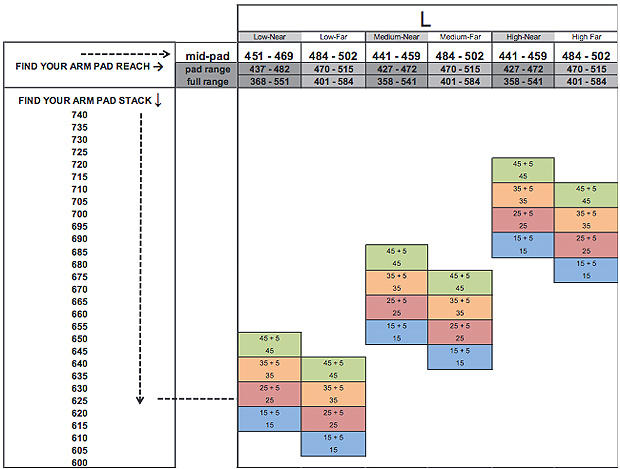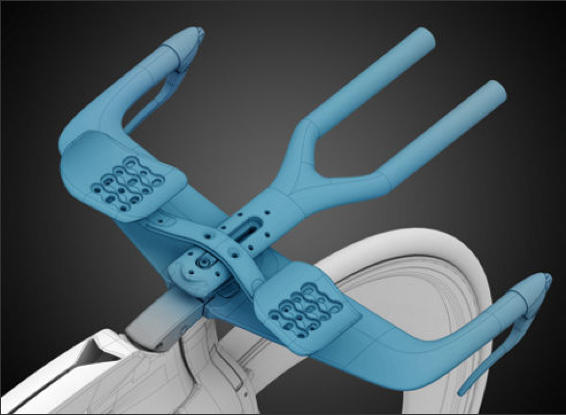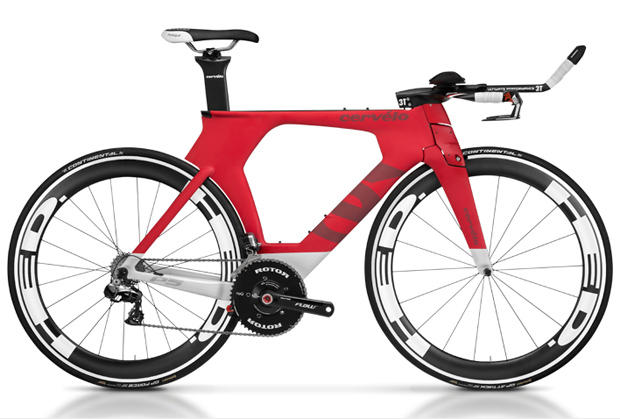Find Your Superbike: Trek
Okay, let's get right to the meat of how this works. Fair warning, there's a little math, a little calculating, but it's straightforward, all the tools you need are here on Slowtwitch. I'm going to do this at my pace, keep up, you're going to have to hang right on my shoulder. Here goes.
Before you can know whether a bike you admire is going to fit you, you have to know how you fit aboard a bike. Not how tall you are, or your inseam. Or your crotch-to-notch or your Retül closed hip angle. You need to know where your saddle is in space, relative to the bottom bracket (both your saddle height and your saddle fore/aft), and you must know where your aerobar pads sit in space, preferably via the bottom bracket. If you know this, you can determine, quickly, whether any bike will or won't work for you, and you can determine it without leaving the chair you're sitting in right now.
In fact, if you knew what I know, you could determine this in about 20 or 30 minutes tops. Any bike. All bikes. What will fit you, what won't fit you, and for those bikes that will fit you, with what front-end configuration. So let's make sure you know what I know.
And, by the way, this is road or tri. Road is monumentally easy. Tri is a little tougher, you guys are smart, so we'll limit this to finding tri bikes that fit.
The time consuming part is figuring out what your position is. You can do this trial and error, over a period of years, or you can go to a fitter, hop on his fit bike, and discover it, or if you are confident you're in a good position now you measure it. You measure your saddle height and setback (or set forward), versus the bottom bracket, and you measure your pad height and pad reach or run or X or whatever you want to call the horizontal distance from the BB to the center of the pad. Measure this on your existing bike, if you're confident in your fit coordinates on that bike.

Above are my fit coordinates for my tri bike. This is how I sit aboard my bike. Note that the image is deceiving in a couple of respects. The saddle nose is clearly behind the BB in the graphic, but "my" saddle nose, on my tri bike, is slightly in front of the BB. It's 85mm behind the BB on my road race bike, but 5mm in front of the BB on my tri bike.
What I'd like to concentrate on now are the two dimensions in shaded red. There are several ways you can measure this. One method: Self-leveling crosshair laser. Another method: Two guys, a level and a measuring tape.
Another method, which is the one I use in my fit studio: If you're aboard a fit bike that outputs X and Y to the handlebar clamp, you measure the pad height and setback (or forward) from the handlebar clamp center, adding pad height to handlebar Y, subtracting pad setback from handlebar X.
Another method: Use an X/Y tool (a tool a lot of fitters and bike shops have) to the pursuit bar, which gives you handlebar X/Y, then add/subtract pad height/setback from handlebar X/Y. Another method: Put your bike in a trainer, make sure it's level, measure from the BB to the floor, and from the pad to the floor, subtract one from the other. That's pad height. Then, for Pad X (or length), hold a level or plumb bob through the BB, follow that vertical line up to pad height (roughly), measure horizontally to pad center.
Any of these methods will work. Some are slightly more precise than others, but don't get too hinky about it. If you're off by 3mm here or 4mm there, that's not enough to cause a bike that would fit you to be excluded from consideration.
Honestly, the elephant in the room here is whether your existing pad placement is optimal. What I'm demonstrating today (and tomorrow and the next day) is how to know, from your existing fit coordinates, which new bikes will work for you, in what sizes and with what front end configurations. How you determine whether your fit coordinates are appropriate, we can talk about that (Lord knows we have talked about that, for 15 years and better, and we'll continue to talk about that), but this isn't the topic for this week.
Using Pad X/Y is the go-to method for discovering what superbikes you'll fit aboard. Today I'm going to talk about one company's process. Tomorrow I'm going to talk about the processes 3 more tri bike makers use. Really, it's the same process, just 3 different calculators, but pretty much the same process. Day after tomorrow we'll talk about how you use Pad X/Y to determine which mortal tri bikes will fit you, and by "mortal" I'm talking about typical frames upon which you bolt a standard stem and aerobars.
Trek Speed Concept
I am horribly editing, truncating, bastardizing Carl Matson's fine, and clever, fit chart and system for the Speed Concept. It is below. I am doing this in order to simplify and zoom in on my specific case. I'm going to find "my" bike over the next several days, finding out whether BMC, Felt, Cervelo, et al, make superbikes that fit me. Then I'll go through a somewhat different process to discover which unsuper tri bikes fit me.
The chart below zooms in on the Speed Concept in frame size Large. This is a portion of the entire fit table, which includes sizes S, M and XL. Further, that fit table discusses pursuit bar positioning, but that's a little more advanced and we're not going to tackle that now.

The Speed Concept is incredibly adjustable, so much so that it would be impossibly complex to try to put all the fit permutations in one system, although Carl Matson (Trek's engineer who designed the SC) and I have talked about it ad nauseum. Here's a hint. An awful lot about bike fit nowadays becomes easier when you look at these X and Y systems as plots on a Cartesian graph, just like you learned (or didn't learn) in high school geometry (I'll bet, in retrospect, you wish you hadn't been smoking pot under the bleachers when they taught this).
My Pad Y, or pad height, is 625mm, remember? And my Pad X is 500mm. If you scroll to Pad Y of 625mm on the left of that chart above, you can then move horizontally along that line and find my Pad X. It sits nicely inside the tightest range of a particular box, and above that box sits the notation: Low-Far. This is the stem. An SC stem doesn't look like other stems. Below is what the stem looks like. This is, I think, a drawing of a Low-Near stem. The Low-Far is the same height profile, just longer. This bike's stem is the thing under the pursuit bar that the bolts go through from underneath.

On top of the stem goes the pursuit bar (base bar), and on top of that goes 1 of 4 pedestals, each successively taller by 10mm. This is a single pedestal rather than the pedestals we see underneath each armrest in most aerobar systems. This raises an interesting question: What is aerodynamically preferable, a lower front end with armrests pedestaled, or frame that is taller but with fewer pedestals? That's a question we would like to try to answer with more specificity this Spring. The big difference in bike set up is that the low front end (a bike with a lower stack), requiring the pads to be pedestaled, usually results in a low pursuit bar position, which you might like and you might not.
Me, that 625mm of Pad Y, that requires a Low stem with a 35mm pedestal. The "35 + 5" above means a 35mm pedestal + a 5mm spacer that sits under the pad wing, and that gives you 5mm of height adjustment all the way up or down the scale.
When you see the ranges in the chart above, you see three ranges per stem. Each range is just a wider version of the range above it. The center of each range is the same. What these ranges mean is that if your Pad Y happens to sit inside the uppermost of the 3 "range" boxes (the tightest range), everything about the SC's front end should be very close to centered in its range. In other words, the pads should probably sit in 1 of the 2 hole sets that are close to the pad center. The wing on which the pads sit should be swept back. The wing should sit right over the center of the pursuit bar.

If your Pad X sits outside of the tightest range, but inside the range that's somewhat more expansive, it means the combo of the frame + the chosen stem (near or far) conspires to present a length that is either on the shorter side or the longer side. You'll need to "pull" the front end of the bike (the extension and the armrests) back, i.e., you'll need to shorten the bike, or you'll need to push the front end out. You'll need to push the mono-extension out or pull it in; maybe place the wing in a more forward hole in the mono-extension if you need more length. Or, push the pads forward and use the rearward hole set. Or, if the bike is too long, you'll need to pull all those elements back.
What is the net result of all this pushing or pulling the front end forward or back? Mostly, it determines where the pursuit position is. Notice that my 500mm of Pad X sits inside the Low-Near stem range, if you look at the most expansive of the 3 ranges (368 – 551). I sometimes complain about the SC's pursuit position as being too far forward. If I chose the Low-Near stem, and pushed the mono-extension and the pads forward, the Near stem would bring the pursuit bars back toward me, but I could still achieve my fit coordinates.
More and more bike makers are coming up with their own versions of the system Carl developed for the Speed Concept. Here is Trek's entire fit table for its Speed Concept. I'll go through the exercise above for those systems in the next installments.





Start the discussion at forum.slowtwitch.com